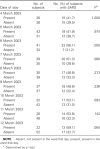Temporal-spatial analysis of severe acute respiratory syndrome among hospital inpatients
- PMID: 15825024
- PMCID: PMC7107882
- DOI: 10.1086/428735
Temporal-spatial analysis of severe acute respiratory syndrome among hospital inpatients
Abstract
Background: We report the temporal-spatial spread of severe acute respiratory syndrome (SARS) among inpatients in a hospital ward during a major nosocomial outbreak and discuss possible mechanisms for the outbreak.
Methods: All inpatients who had stayed in the same ward as the initial index case patient for any duration before isolation were recruited into a cohort and followed up to document the occurrence of SARS. The normalized concentration of virus-laden aerosols at different locations of the ward was estimated by use of computational fluid dynamics modeling. The attack rates in the various subgroups stratified by bed location were calculated. Multivariate Cox proportional hazards regression was used to document important risk factors.
Results: The overall attack rate of SARS was 41% (30 of 74 subjects). It was 65%, 52%, and 18% in the same bay, adjacent bay, and distant bays, respectively (P = .001). Computation fluid dynamics modeling indicated that the normalized concentration of virus-laden aerosols was highest in the same bay and lowest in the distant bays. Cox regression indicated that staying in the ward on 6 or 10 March entailed higher risk, as well as staying in the same or adjacent bays. The epidemic curve showed 2 peaks, and stratified analyses by bed location suggested >1 generation of spread.
Conclusions: The temporal-spatial spread of SARS in the ward was consistent with airborne transmission, as modeled by use of computational fluid dynamics. Infected health care workers likely acted as secondary sources in the latter phase of the outbreak.
Figures







References
-
- World Health Organization . Severe acute respiratory syndrome (SARS): multi-country outbreak—update, March 16, 2003. Available at: http://www.who.int/csr/don/2003_03_16/en. Accessed 25 October 2004.
-
- Update: outbreak of severe acute respiratory syndrome—worldwide, 2003. MMWR Morb Mortal Wkly Rep. 2003;52:241–8. - PubMed
-
- Lee N, Hui D, Wu A, et al. A major outbreak of severe acute respiratory syndrome in Hong Kong. N Engl J Med. 2003;348:1986–94. - PubMed
-
- Department of Health, Hong Kong Special Administrative Region . Outbreak of severe acute respiratory syndrome (SARS) at Amoy Gardens, Kowloon Bay, Hong Kong—main findings of investigation, 17 April 2003. Available at: http://www.info.gov.hk/info/ap/pdf/amoy_e.pdf. Accessed 25 October 2004.
Publication types
MeSH terms
LinkOut - more resources
Full Text Sources
Other Literature Sources
Medical
Miscellaneous

